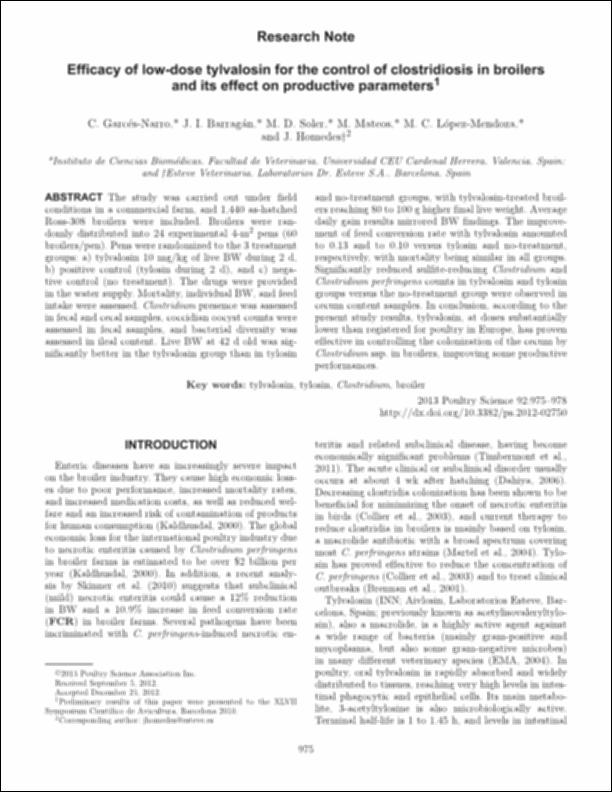Please use this identifier to cite or link to this item:
http://hdl.handle.net/10637/16287Efficacy of low-dose tylvalosin for the control of clostridiosis in broilers and its effect on productive parameters
| Title: | Efficacy of low-dose tylvalosin for the control of clostridiosis in broilers and its effect on productive parameters |
| Authors : | Garcés Narro, Carlos Barragán Cos, José Ignacio Soler Sanchis, María Dolores Mateos Otero, Milagros López Mendoza, María Carmen Homedes, Josep |
| Keywords: | Ave de corral; Poultry; Enfermedad animal; Animal diseases; Clostridium ssp.; Tylvalosin; Tylosin |
| Publisher: | Elsevier Poultry Science Association |
| Citation: | Garcés-Narro, C., Barragán, J.I., Soler, M.D., Mateos, M., López-Mendoza, M.C., & Homedes, J. (2013). Efficacy of low-dose tylvalosin for the control of clostridiosis in broilers and its effect on productive parameters. Poultry Science, 92(4), 975–978. https://doi.org/10.3382/ps.2012-02750 |
| Abstract: | The study was carried out under field conditions in a commercial farm, and 1,440 as-hatched Ross-308 broilers were included. Broilers were randomly distributed into 24 experimental 4-m2 pens (60 broilers/pen). Pens were randomized to the 3 treatment groups: a) tylvalosin 10 mg/kg of live BW during 2 d, b) positive control (tylosin during 2 d), and c) negative control (no treatment). The drugs were provided in the water supply. Mortality, individual BW, and feed intake were assessed. Clostridium presence was assessed in fecal and cecal samples, coccidian oocyst counts were assessed in fecal samples, and bacterial diversity was assessed in ileal content. Live BW at 42 d old was significantly better in the tylvalosin group than in tylosin and no-treatment groups, with tylvalosin-treated broilers reaching 80 to 100 g higher final live weight. Average daily gain results mirrored BW findings. The improvement of feed conversion rate with tylvalosin amounted to 0.13 and to 0.10 versus tylosin and no-treatment, respectively, with mortality being similar in all groups. Significantly reduced sulfite-reducing Clostridium and Clostridium perfringens counts in tylvalosin and tylosin groups versus the no-treatment group were observed in cecum content samples. In conclusion, according to the present study results, tylvalosin, at doses substantially lower than registered for poultry in Europe, has proven effective in controlling the colonization of the cecum by Clostridium ssp. in broilers, improving some productive performances. |
| Description: | Los resultados preliminares de esta investigación fueron presentados en el XLVII Symposium Científico de Avicultura, Barcelona 2010. |
| URI: | http://hdl.handle.net/10637/16287 |
| Rights : | http://creativecommons.org/licenses/by-nc-nd/4.0/deed.es Open Access |
| ISSN: | 0032-5791 1525-3171 (Electrónico) |
| Issue Date: | Apr-2013 |
| Center : | Universidad Cardenal Herrera-CEU |
| Appears in Collections: | Dpto. Producción y Sanidad Animal, Salud Pública Veterinaria y Ciencia y Tecnología de los Alimentos |
Items in DSpace are protected by copyright, with all rights reserved, unless otherwise indicated.


